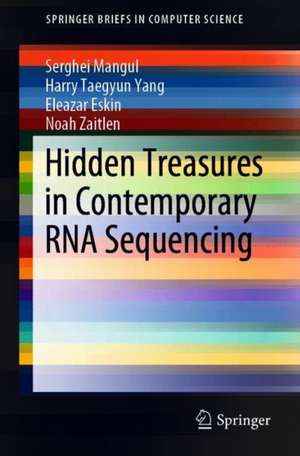Hidden Treasures in Contemporary RNA Sequencing: SpringerBriefs in Computer Science
Autor Serghei Mangul, Harry Taegyun Yang, Eleazar Eskin, Noah Zaitlenen Limba Engleză Paperback – 13 mar 2019
Advances in RNA-sequencing (RNA-seq) technologies have provided an unprecedented opportunity to explore the gene expression landscape across individuals, tissues, and environments by efficiently profiling the RNA sequences present in the samples. When a reference genome sequence or a transcriptome of the sample is available, mapping-based RNA-seq analysis protocols align the RNA-seq reads to the reference sequences, identify novel transcripts, and quantify the abundance of expressed transcripts.
The reads that fail to map to the human reference, known as unmapped reads, are a large and often overlooked output of standard RNA-seq analyses. Even in carefully executed experiments, the unmapped reads can comprise a considerable fraction of the complete set of reads produced, and can arise due to technical sequencing produced by low-quality and error-prone copies of the nascent RNA sequence being sampled. Reads can also remain unmapped due to unknown transcripts, recombined Band T cell receptor sequences, A-to-G mismatches from A-to-I RNA editing, trans-splicing, gene fusion, circular RNAs, and the presence of non-host RNA sequences (e.g. bacterial, fungal, and viral organisms). Unmapped reads represent a rich resource for the study of B and T cell receptor repertoires and the human microbiome system—without incurring the expense of additional targeted sequencing.
This book introduces and describes the Read Origin Protocol (ROP), a tool that identifies the origin of both mapped and unmapped reads. The protocol first identifies human reads using a standard high-throughput algorithm to map them onto a reference genome and transcriptome. After alignment, reads are grouped into genomic (e.g. CDS, UTRs, introns) and repetitive (e.g. SINEs, LINEs, LTRs) categories. The rest of the ROP protocol characterizes the remaining unmapped reads, which failed to map to the human reference sequences.
Din seria SpringerBriefs in Computer Science
-
 Preț: 475.83 lei
Preț: 475.83 lei - 20%
 Preț: 166.97 lei
Preț: 166.97 lei - 20%
 Preț: 325.63 lei
Preț: 325.63 lei - 20%
 Preț: 349.13 lei
Preț: 349.13 lei - 20%
 Preț: 302.48 lei
Preț: 302.48 lei -
 Preț: 381.81 lei
Preț: 381.81 lei -
 Preț: 446.47 lei
Preț: 446.47 lei - 20%
 Preț: 296.17 lei
Preț: 296.17 lei - 20%
 Preț: 335.65 lei
Preț: 335.65 lei - 20%
 Preț: 463.83 lei
Preț: 463.83 lei - 20%
 Preț: 323.00 lei
Preț: 323.00 lei - 20%
 Preț: 322.35 lei
Preț: 322.35 lei - 20%
 Preț: 321.85 lei
Preț: 321.85 lei - 20%
 Preț: 232.68 lei
Preț: 232.68 lei -
 Preț: 375.45 lei
Preț: 375.45 lei - 20%
 Preț: 323.00 lei
Preț: 323.00 lei - 20%
 Preț: 322.81 lei
Preț: 322.81 lei - 20%
 Preț: 324.17 lei
Preț: 324.17 lei - 20%
 Preț: 323.00 lei
Preț: 323.00 lei - 20%
 Preț: 322.17 lei
Preț: 322.17 lei - 20%
 Preț: 322.50 lei
Preț: 322.50 lei - 20%
 Preț: 323.34 lei
Preț: 323.34 lei - 20%
 Preț: 324.17 lei
Preț: 324.17 lei - 20%
 Preț: 323.46 lei
Preț: 323.46 lei - 20%
 Preț: 322.17 lei
Preț: 322.17 lei - 20%
 Preț: 322.02 lei
Preț: 322.02 lei -
 Preț: 341.50 lei
Preț: 341.50 lei - 20%
 Preț: 324.49 lei
Preț: 324.49 lei -
 Preț: 344.47 lei
Preț: 344.47 lei -
 Preț: 376.80 lei
Preț: 376.80 lei -
 Preț: 377.18 lei
Preț: 377.18 lei - 20%
 Preț: 324.17 lei
Preț: 324.17 lei - 20%
 Preț: 352.26 lei
Preț: 352.26 lei - 20%
 Preț: 321.32 lei
Preț: 321.32 lei - 20%
 Preț: 322.17 lei
Preț: 322.17 lei - 20%
 Preț: 324.17 lei
Preț: 324.17 lei - 20%
 Preț: 322.02 lei
Preț: 322.02 lei -
 Preț: 374.46 lei
Preț: 374.46 lei - 20%
 Preț: 320.21 lei
Preț: 320.21 lei - 20%
 Preț: 323.34 lei
Preț: 323.34 lei - 20%
 Preț: 324.17 lei
Preț: 324.17 lei - 20%
 Preț: 231.84 lei
Preț: 231.84 lei - 20%
 Preț: 294.95 lei
Preț: 294.95 lei - 20%
 Preț: 322.50 lei
Preț: 322.50 lei - 20%
 Preț: 323.46 lei
Preț: 323.46 lei -
 Preț: 374.08 lei
Preț: 374.08 lei -
 Preț: 408.23 lei
Preț: 408.23 lei - 20%
 Preț: 321.52 lei
Preț: 321.52 lei - 20%
 Preț: 323.34 lei
Preț: 323.34 lei - 20%
 Preț: 323.00 lei
Preț: 323.00 lei
Preț: 350.81 lei
Nou
Puncte Express: 526
Preț estimativ în valută:
67.13€ • 69.95$ • 55.58£
67.13€ • 69.95$ • 55.58£
Carte tipărită la comandă
Livrare economică 31 martie-05 aprilie
Preluare comenzi: 021 569.72.76
Specificații
ISBN-13: 9783030139728
ISBN-10: 3030139727
Pagini: 115
Ilustrații: V, 93 p. 49 illus., 48 illus. in color.
Dimensiuni: 155 x 235 x 7 mm
Greutate: 0.18 kg
Ediția:1st ed. 2019
Editura: Springer International Publishing
Colecția Springer
Seria SpringerBriefs in Computer Science
Locul publicării:Cham, Switzerland
ISBN-10: 3030139727
Pagini: 115
Ilustrații: V, 93 p. 49 illus., 48 illus. in color.
Dimensiuni: 155 x 235 x 7 mm
Greutate: 0.18 kg
Ediția:1st ed. 2019
Editura: Springer International Publishing
Colecția Springer
Seria SpringerBriefs in Computer Science
Locul publicării:Cham, Switzerland
Cuprins
Abstract.- Main Text.- Acknowledgement.- Disclosure.- References.
Notă biografică
Dr. Serghei Mangul is a Postdoctoral Fellow at the University of California, Los Angeles, where he holds a Collaboratory Fellowship from the Institute for Quantitative and Computational Biosciences.
Caracteristici
Focuses on revealing the features hidden in unmapped reads, which traditional RNA-sequencing research commonly regards as uninformative Highlights how a comprehensive search for the origin of unmapped reads can reveal characteristics about the sample’s immune repertoire
